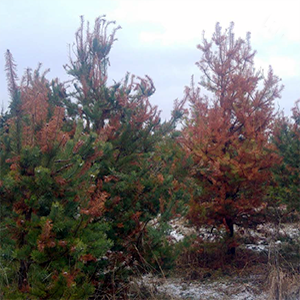Contact
jonas.oliva@slu.se, 018-671602

Jonàs Oliva has received a grant from Formas to investigate the fungi Diplodia pinea that attack pines. The first major outbreak of the pathogen was discovered in September 2016 in a stand of planted pine trees near Arlanda.
The recieved Formas grant is an urgent grant that enables researchers to manage rapidly developing research opportunities, which needs to be taken advantage of during a limited time frame.
Diplodia pinea may pose a threat for the second most important tree species in Sweden, Scots pine. This pathogen is common in Southern Europe, though lately outbreaks have been reported more and more northwards. Diplodia pinea may represent a clear case of an emergent pathogen expanding its range northwards due to global warming. The outbreak in September 2016 nearby Arlanda is the first outbreak on stand level in Sweden and covered ca 30 ha plantations.
The pathogen damage current year shoots, including the leader shoot. Trees in the stand will likely grow less and develop bushy crowns. We know that the pathogen has been present in Sweden at least since 2013, when it was discovered for the first time nearby Fjällnora, 40 km north of Arlanda.
Now, Jonàs Oliva together with Jan Stenlid from the Department of Forest Mycology and Plant Pathology, have gotten the opportunity to investigate the pathogen to make a proper risk assessment.
– With this study, we want to find out if this is a new pathogen, how large the damages are, if the outbreak is related to weather conditions, if there are other outbreaks and how fast is has spread so far, says Jonàs Oliva.
– We hope to deliver information about this pathogen as soon as possible to the Swedish Forest Agency, that then can give advice to forest owners. In particular to those that already have highly damaged plantations, says Jan Stenlid.
Counter measures such as eradication could still be technically viable, depending on how widespread the outbreak is.
jonas.oliva@slu.se, 018-671602